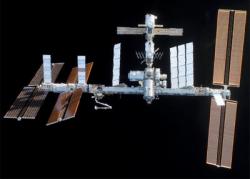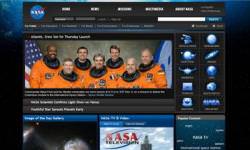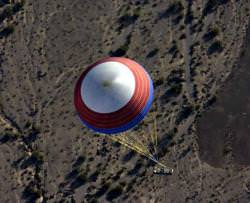NASA is encouraging Earthlings to send a holiday greeting to the members of Expedition 16 on board the International Space Station. NASA’s Homepage contains a link to send your holiday good wishes to the crew with pre-made e-postcards. The sentiment is nice, however the cards seem a little backwards.
One e-card has a picture of the ISS with a caption that says “The View From 220 Miles Up,” while another displays a waving EVA astronaut saying “Wish You Were Here.” These cards are supposed to be to the crew and from Earth, so perhaps more appropriate might be a picture of a snowy holiday scene or a majestic Earth landscape with the caption “Wish You Were Here, But Glad You Are Up There Furthering the Advances of Human Spaceflight.”
But take this opportunity to express yourself to the ISS crew.
And now on to more pressing news from the ISS:
Space shuttle Atlantis’ STS-122 mission to the space station has now been delayed to no earlier than January 10, 2008.
“Moving the next launch attempt of Atlantis to Jan. 10 will allow as many people as possible to have time with family and friends at the time of year when it means the most,” said shuttle Program Manager Wayne Hale. “A lot has been asked of them this year and a lot will be asked of them in 2008.”
Additionally, it gives engineers more time to understand the engine cutoff sensor problem that has kept the shuttle on the ground. An original launch of Dec. 6 was scrubbed when the sensors failed in a routine test during fueling of the shuttle’s external tank. The problem re-occurred in subsequent tanking test during countdown on Dec. 9, which caused NASA officials to decide to delay the launch until after the first of the year.
STS-122 will bring the Columbus science module to the station, the European Space Agency’s major contribution to the ISS. In addition to conducting three spacewalks to outfit the new science module, shuttle astronauts would also have done a fourth EVA to inspect a troublesome solar array rotary joint on the ISS’s power-providing solar panels that is contaminated with metallic shavings.
So instead ISS astronauts Peggy Whitson and Dan Tani will do that inspection on a spacewalk on Tuesday, December 18 starting at 6:00am EST. They will also look at another more recent power system problem that could be the result of a micrometeoroid or debris impact. On Dec. 8, two circuit breakers tripped, possibly the result of a space debris impact that might have damaged the mechanism that allows power and data to flow through the rotary joint used to turn the array about its axis.
For the SARJ problem, the starboard SARJ is locked in place because of excessive vibration and the metallic shavings and “bearing race ring” damage that were discovered during a quick inspection during the last shuttle mission. The SARJ has two drive gears and two redundant drive motors.
Whitson and Tani could install new bearings on the undamaged race ring and reposition the motors. The other option is to clean up the contamination and fix whatever is causing the problem.
“Once they have more data, they can make a better assessment of which of those approaches we should do, whether we should clean up the current race ring or just shift over,” ISS Commander Peggy Whitson said in a news conference from the station on Thursday morning. “I think either one’s doable,” she continued. “To me, in my mind, I think it would be probably, from an astronaut’s perspective, easier to just shift to the other race ring rather than trying to clean it up. But we don’t know yet how easy that’s going to be to clean up.”
Kirk Shireman, deputy manager of the space station program at the Johnson Space Center, said in a later news conference that no decisions will be made until engineers have more information about what might be causing the problem. The port-side solar arrays and that SARJ is operating normally.
“The idea is, we’ll conduct the EVA right now, the SARJ inspection and the BGA inspection, and we’ll learn what we need to learn,” Shireman said. “Then we’ll find the most opportune time to go fix it, not only the BGA but hopefully the SARJ. It really depends on how our analysis comes out. We’ll figure out exactly how long we can go with the BGA locked and the SARJ restrictions we have in place.”
Back to some holiday frivolity, since Tani would have returned to Earth with the STS-122 crew, which was originally scheduled to return home around the 19th of December, he wasn’t supposed to be on board the ISS during Christmas. Reporters inquired about his change of holiday plans and how gift arrangements were being handled. When asked, Commander Whitson declined to answer if all Tani would be receiving from her would be a lump of coal, saying she didn’t want to give away the surprise.
The astronauts said they have been hoarding foods like smoked turkey and other holiday-type goodies, saving them for Christmas dinner, so it appears that Atlantis and STS-122 were supposed to deliver the holiday meal. However a Progress re-supply ship will be docking with the ISS on Christmas Day, and one of the first things to be unpacked are hamburgers and fresh tomatoes and lettuce. Since fresh foods are a rare commodity on board the station, an All-American burger will be a welcome holiday treat for the crew.
Expedition 16 has also recorded a holiday message to Earth. Watch it here
Original News Source: NASA Press Release, NASA TV



